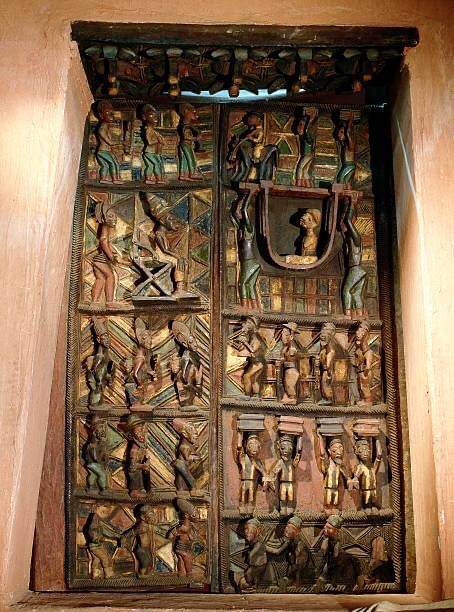Renowned for his exceptional wood sculpting skills and innovative artistic vision, Olowe of Ise stands as a luminary figure among the Yoruba artists of the late 19th century. In this exploration, we delve into the intricacies of Olowe’s craftsmanship, focusing on a masterpiece that embodies his genius – the doors from the Palace at Ikere Ekiti. These intricately carved doors serve as a testament to Olowe’s talent and the rich cultural history of the Yoruba people.
The Palace at Ikere Ekiti: A Historical Marvel
A Glimpse into History
Circa the late 19th century, Ekiti witnessed a significant historical event that would forever be etched in its chronicles. It was in this era that Captain Ambrose, the first British official to visit the region, was received by the Ogaga of Ikere. This historic moment is immortalized in the central panel of the Palace at Ikere Ekiti’s doors, meticulously carved by Olowe of Ise.
The Significance of the Central Panel
The central panel of the Palace doors captures the essence of this historical encounter, portraying the Ogaga of Ikere extending his welcome to Captain Ambrose. This carving not only reflects the diplomatic exchange between the Yoruba kingdom and the British Empire but also showcases Olowe’s artistic prowess in vivid detail.
Olowe of Ise: The Artistic Visionary
An Introduction to Olowe
Olowe of Ise, also known as Ọlọ́wẹ̀ of Ìsẹ̀, was born around 1873 in Efon-Alaiye, a town renowned for its cultural significance in Yorubaland. However, the bulk of his illustrious career unfolded in the city of Ise. What sets Olowe apart is his status as a wood sculptor and a master innovator, with a profound impact on the African design style known as Oju-ona.
The Enigmatic Origins
The genesis of Olowe’s artistic journey is shrouded in mystery. It remains a subject of debate whether his artistic prowess emerged from a formal apprenticeship or purely from his innate talent. What is indisputable, though, is that Olowe’s reputation as a sculptor blossomed in Ise, under the patronage of King Arinjale, the Oba of Ise.
From Local Fame to Regional Acclaim
Olowe’s artistic acclaim didn’t confine itself to Ise alone. His talents transcended borders, spreading throughout eastern Yorubaland. Summoned to towns such as Ilesa, Ikere, Akure, Idanre, and Ogbagi, Olowe embarked on a creative journey spanning a 60-mile radius (approximately 96.75 kilometers). In these locales, he crafted elaborate household items, veranda posts, personal artifacts, and ritual objects for affluent families.
The Legacy of Olowe of Ise
A Lasting Impact
Olowe of Ise’s legacy reverberates through the annals of Yoruba art history. His innovative designs, intricate carvings, and distinctive style continue to captivate art historians and collectors alike. The doors from the Palace at Ikere Ekiti serve as a testament to his enduring influence.
Preservation of Cultural Heritage
Olowe’s work transcends mere artistic expression; it embodies the cultural heritage of the Yoruba people. His carvings are not just decorative pieces; they are windows into the past, narrating tales of diplomacy, tradition, and craftsmanship.
Conclusion
The doors from the Palace at Ikere Ekiti, sculpted by Olowe of Ise, stand as a testament to the artistic genius and cultural significance of this renowned Yoruba artist. As we admire the intricacies of these carvings, we also pay homage to the rich history and heritage they represent. Olowe’s legacy endures, reminding us of the power of art to transcend time and speak to the essence of humanity’s shared history.




GIPHY App Key not set. Please check settings